How often do you find yourself staring blankly at your computer screen, desperately trying to come up with an engaging social media post? Even the best marketers hit creative roadblocks when it comes to social media content creation. But the good news is you don’t have to figure it all out on your own.
Whether you need a fresh perspective or just a little inspiration, we’ve got you covered. We’re tackling social media content creation and exploring the tried-and-true best practices that can elevate your posts from good to great.
From understanding your target audience to optimizing your content for different platforms, we’ll walk you through the step-by-step process of crafting engaging posts that resonate. Along the way, we’ll share real-life examples, expert insights, and actionable tips. But before we get started on those steps, let’s cover the basics.
What Is Social Media Content Creation?
To keep it simple, social media content creation is exactly what it sounds like: creating the content that fills up your brand’s social media feeds. It’s the foundation of any social media strategy because, without content, there’s nothing to engage with.
But it’s not just about making something and posting it. Good content is intentional. It’s designed to connect with your audience, tell your brand’s story, and (ideally) drive some kind of action — whether that’s a like, a comment, or a sale.
For brands, content creation can sometimes feel like an endless cycle. But when done right, it’s a powerful way to build relationships, boost brand awareness, and keep your audience engaged. The key is knowing what kind of content works best for your brand and audience, which brings us to our next point.
Types of Social Media Content
Social media isn’t one-size-fits-all. Different platforms favor different content styles, and your audience likely engages with a mix of formats. Here’s a rundown of what you’ll be working with:
- Images: The backbone of most social platforms. This includes single images, carousels (multi-image posts that let users swipe through), and designed graphics or infographics.
- Videos: We’ve got short-form (Reels, TikToks, Shorts), long-form (YouTube, LinkedIn webinars), live videos, and even different orientations (vertical vs. horizontal). Whether you’re looking to create attention-grabbing content or dive deep with detailed tutorials, videos offer endless possibilities.
- Captions: More than just words under a post, captions can educate, entertain, or inspire action. They can be short and snappy or long-form storytelling, depending on your brand’s style.
- Stories & Ephemeral Content: Typically lasting only 24 hours, this type of content is great for sharing casual, time-sensitive updates.
- Text-Based Posts: Popular on platforms like Twitter (X) and LinkedIn, these posts can range from long and thought-provoking to short and funny.
- Interactive Content. Encourage audience participation by posting interactive content such as polls, quizzes, contests, and interactive stories. Not only are they an effective way to boost engagement, but you can also gain valuable customer insights.
- User-Generated Content (UGC): Sharing content your customers create about your brand can build trust and encourage more engagement.
- GIFs and Memes: Injecting humor and relatability into your social media strategy can help you resonate with your audience. These light-hearted and often viral content formats can help humanize your brand and add a touch of fun to your posts.
Each type of content serves a different role, and the best social media strategies mix them up to keep things fresh. The goal? To create content that feels valuable and engaging — not just noise in someone’s feed.
Top Tools for Social Media Content Creation
Now that we’ve covered the types of social media content you can create, let’s talk tools. Having the right tools in your arsenal can make a world of difference in streamlining your workflow, boosting creativity, and maintaining consistency. Here are some essential categories of tools you might want to explore:
- Design & Editing Tools: For creating eye-catching visuals and graphics. Consider Canva for a beginner-friendly interface or Adobe Creative Cloud for more comprehensive editing capabilities.
- Video Editing Tools: To create and polish video content, whether that means quick clips or longer narratives. CapCut and InShot are two popular tools you might want to try.
- Collaboration & Project Management Tools: Stay organized and on top of your content schedule with tools like Trello for project management or Slack for team communication.
- Scheduling & Automation Tools: To plan posts and automate your content calendar across platforms. Buffer, Sendible, and Later are a few examples.
- Analytics & Reporting Tools: For tracking performance, measuring engagement, and refining your strategy based on data. Most social platforms report native analytics, but you can also use a dedicated social media analytics platform like Rival IQ.
Having these tools in your toolkit sets the foundation, but truly effective social media content creation requires a strategy. Let’s dive into the seven essential steps for creating content that resonates with your audience.
1. Establish Your Goals
When it comes to social media content, it’s easy to get caught up in the frenzy of posting without a clear purpose. That’s why taking the time to define your goals upfront is key.
Are you looking to boost brand awareness or increase website traffic? Is your focus on generating leads or strengthening customer engagement? Establishing clear goals provides a roadmap for your content strategy, helping you stay focused and align your efforts with your overall business objectives.
For instance, let’s say your goal is to generate leads. In this case, you may want to create content that offers value to your audience and encourages them to take action. Consider crafting enticing offers, such as downloadable guides or free trials, and promoting them through well-crafted social media posts that highlight the benefits.
When setting goals for your social media content, it’s important to ensure they are specific, measurable, attainable, relevant, and time-bound (SMART). For example, rather than aiming for generic goals like “increase followers,” consider setting more targeted objectives like “increase organic followers by 10% within the next three months.”
By establishing clear goals, you’ll be able to create content that drives meaningful results. Setting goals is an ongoing process, so regularly evaluate your progress and adjust your content strategy accordingly.
2. Get to Know Your Audience
Understanding your audience is the foundation of effective social media content creation. You can have the most visually stunning posts and the wittiest captions, but if they don’t resonate with your target audience, they won’t generate the desired engagement.
To truly get to know your audience, it’s important to dig deeper than just demographics. Take the time to understand their needs, challenges, and aspirations. What motivates them? What are their pain points? Conducting audience research and analyzing data can provide valuable insights that inform your content strategy.
It will also help to understand their social media habits. Which platforms are most popular with your target audience? What kind of content has been trending among them? If you already have an established audience, you can even learn more about the day and times they’re most active on a particular platform, allowing you to tune in on the best times to post.
With Rival IQ, you can even compare your performance to your competitive landscape to find opportunities for increased engagement, as shown below.
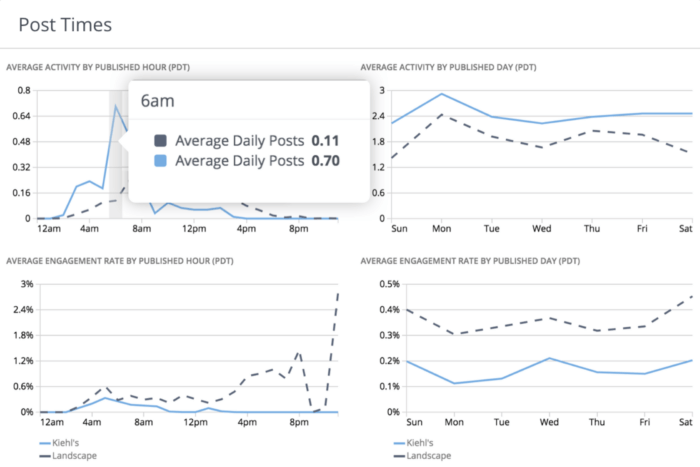
Keep in mind that your social media content isn’t just about promoting your brand. You want to provide value to your audience and build a genuine connection. By getting to know your audience and creating content that speaks to their interests and needs, you can encourage engagement and loyalty and, ultimately, drive your social media success.
3. Research the Competition
Staying on top of the latest trends and tactics is crucial for creating good content. One effective way to gain inspiration and insights is by researching and analyzing what your competitors are doing.
By studying their successful content, you can learn valuable lessons, identify gaps in the market, and discover new ideas to incorporate into your own strategy. Here’s how to get started.
Identify Your Competitors
Start by identifying your direct competitors in your industry or niche. Look for brands that have a similar target audience and are actively engaging on social media platforms. For instance, if you’re in the fitness industry, you may want to analyze successful content from brands like Nike or Gymshark.
Analyze Their Top-Performing Content
Dive deep into your competitors’ social media profiles and explore their content strategies. Pay attention to the type of content they share, their posting frequency, and the engagement they receive. Look for patterns or themes that resonate with their audience.
As an example, you could take a quick look at Gymshark’s Instagram and see how the brand has built a massive following by sharing inspiring workout videos, posting motivational messages, and showcasing its products in action through user-generated content.
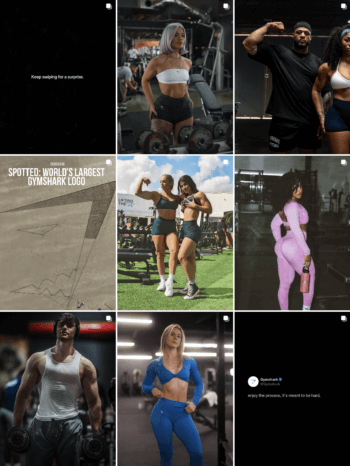 You can then take your analysis a step further with tools that provide more insights into your competitors’ performance. For instance, with Rival IQ, you’d learn that Gymshark also saw major success with posts about its Lift: Miami event. Official photos from the event (rather than just UGC) were some of its most engaging posts this year — an insight that’s not super obvious from just looking at its page.
You can then take your analysis a step further with tools that provide more insights into your competitors’ performance. For instance, with Rival IQ, you’d learn that Gymshark also saw major success with posts about its Lift: Miami event. Official photos from the event (rather than just UGC) were some of its most engaging posts this year — an insight that’s not super obvious from just looking at its page.
For instance, the post below earned a 1.8% engagement rate by follower. That’s more than double its average engagement rate for the year so far (0.73%).

Draw Inspiration but Stay True to Your Brand
While researching your competition, don’t be afraid to draw inspiration from their successful content. Of course, the goal is not to copy your competitors outright but rather to learn from their success and adapt it to your unique brand style. Be open to learning from others while striving to create content that reflects your brand’s voice, personality, and values.
4. Craft Content for Different Platforms
Each platform has its own unique characteristics and audience preferences, so understanding these nuances will help you create content that truly resonates. Here are some platform-specific tips to elevate your social media game.
With its focus on visual storytelling, Instagram offers a great opportunity to showcase your brand’s personality and aesthetic. Brands that can deliver eye-catching and entertaining visuals thrive on this platform. An excellent example of this is National Geographic, which shares captivating images alongside inspirational stories to engage its audience.
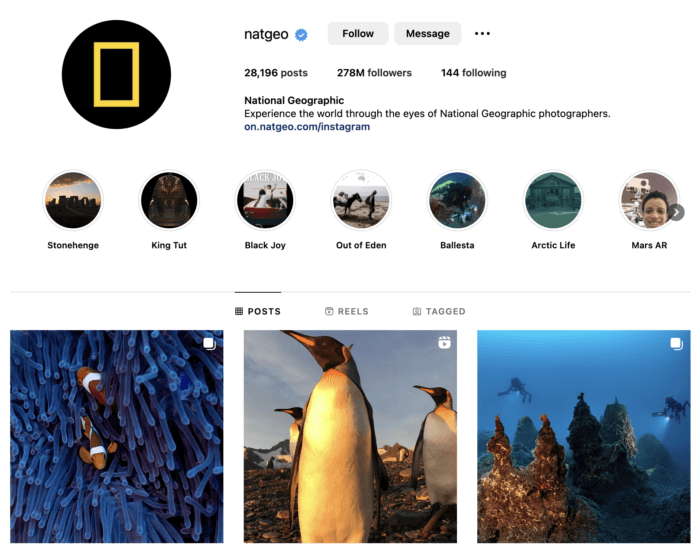
Be intentional with the quality of the images and videos that you post on Instagram. Leverage Instagram Stories to share behind-the-scenes glimpses, conduct polls, or even host Q&A sessions to encourage audience engagement. Explore the use of relevant hashtags to expand your reach and consider collaborating with influencers to boost your brand’s visibility.
With its roots as a micro-blogging site, Twitter is all about concise and timely communication. Craft short, snappy tweets to match the fast-paced nature of Twitter. Use hashtags strategically and participate in relevant conversations. Take advantage of Twitter’s multimedia options by eye-catching sharing images, videos, and GIFs to make your tweets stand out in the quick-moving feed.
Don’t be afraid to let your brand personality boldly come through in your tweets. Brands like Wendy’s, for instance, have embraced their unique brand voice, incorporating witty memes and funny GIFs into their Twitter strategy, earning them a loyal following and driving engagement. In fact, the fast food brand continues to thrive on Twitter despite multiple industries seeing a notable decline on the platform.
As our 2025 Social Media Industry Benchmark Report revealed, the median engagement rate on Twitter across all industries is 0.015%, around half of the rate of the year before (0.029%). Meanwhile, Wendy’s has achieved an average engagement rate of 0.16% so far this year. Some posts, like the one below about the TikTok ban, scored a 0.64% engagement rate (that’s 42x greater than the median!).

With its diverse user base, Facebook offers a broader canvas for content. On this platform, feel free to mix up your posts with a combination of text, images, videos, and links in order to create engaging posts that spark conversations and encourage audience interaction. Consider also leveraging Facebook Live to engage in real time with your audience through Q&A sessions, product demonstrations, or behind-the-scenes tours. https://www.rivaliq.com/blog/top-industries-using-twitter/
Netflix is one example of a brand that’s really embraced all the different content formats Facebook has to offer, from video trailers to sneak-peek images of upcoming episodes. For instance, the streaming giant takes advantage of how easy it is to share links on Facebook, using the platform to direct its audience to articles on Netflix Tudum, its official companion site that delivers exclusive interviews, behind-the-scenes content, and more.

TikTok
Known for its short-form videos, TikTok thrives on creativity and embraces trends. Experiment with catchy music, engaging transitions, and creative effects to make your content stand out. Go all in with the platform’s trending challenges and audios to create content that’s relevant and resonates with your target audience.
With countless creators making waves on the app, you can also collaborate with influencers to amplify your reach and engage with the platform’s highly interactive community. For instance, Chime worked with Keith Lee, the taste-testing TikToker with 17M followers, and Dallas Mavericks Center Dereck Lively II, to treat shoppers to a free month of groceries for Random Acts of Kindness Day.
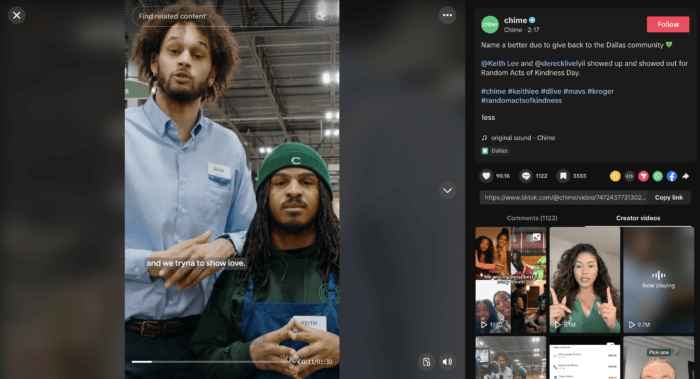
5. Experimenting with Diverse Content Types
By incorporating a range of media elements, you can keep your followers engaged and tap into their varied preferences. Experimentation is key. Don’t be afraid to test new content styles, try out emerging formats, and adapt them to your brand’s unique voice.
More importantly, you want to take note of what works well for your audience and adjust accordingly. What type of post generates the highest engagement? What about for others in your competitive landscape?
For instance, a look at the beauty brand Benefit’s post type analysis shows that, while the brand mostly posts reels, it’s actually carousels that garner the most engagement in its landscape.
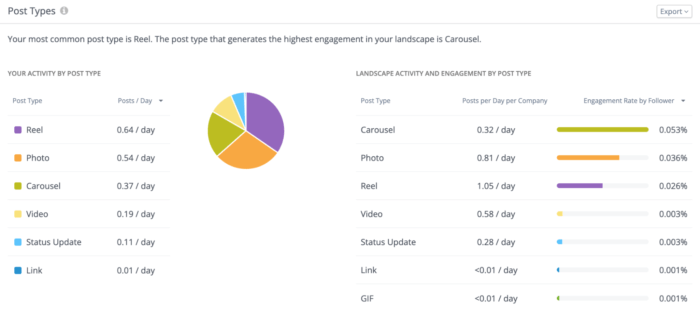
If Benefit’s looking to boost engagement, experimenting with more carousel posts would certainly be a good place to start.
6. Engage Through Authenticity
In today’s social media landscape, authenticity has become a key driver in building a strong social media presence. People crave genuine connections and want to engage with brands that are transparent and real. By embracing authenticity, you can build a strong social media presence that fosters trust, loyalty, and meaningful interactions.
One effective way to engage your audience is by sharing behind-the-scenes moments and personal stories. Take inspiration from brands like Glow Recipe, who often give their followers a glimpse into their process, such as in the post below showing how they got an iconic photo. By being transparent about your business, you build trust and foster a sense of loyalty.
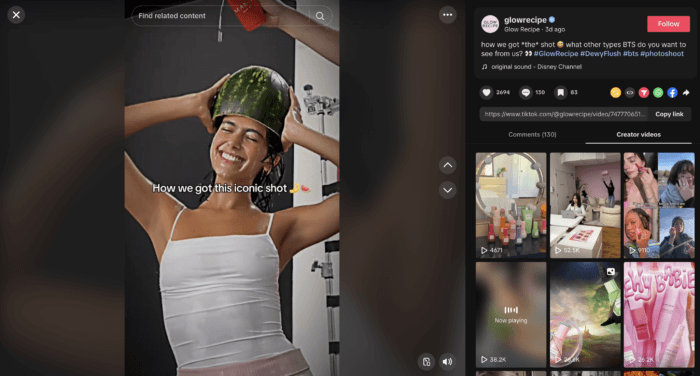
Maintaining a consistent brand voice and style is also crucial. Whether it’s a witty and playful tone like Wendy’s on Twitter or a polished and aspirational style like Nike’s on Instagram, find a voice that aligns with your brand values and appeals to your target audience. Consistency across platforms can help you create a recognizable and memorable brand identity.
Finally, don’t forget to actually interact with your audience. With engagement as the most valuable currency on social, be sure to encourage interactions and initiate conversations. Respond to comments, acknowledge feedback, and show appreciation for your followers. By nurturing these interactions, you’ll create an engaged community around your brand and a social media presence that stands out from the crowd.
7. Track and Improve Your Success
Social media content creation is just the first step. To truly maximize your impact and continuously improve, you need to track and measure your success. By monitoring the performance of your content, you can gain valuable insights into what works and what doesn’t, enabling you to refine your strategy and achieve better results.
Collect data on how well your content performs, then look for patterns and correlations between your content and the metrics. Analyze which types of posts generate the most engagement, which platforms yield the highest reach, which content drives the most conversions, etc.
Fortunately, there are various tools and platforms available to help you measure and analyze your social media performance. For instance, with our user-friendly interface and robust features, Rival IQ makes it easy to track your social media metrics and benchmark your success against your competitors.
Start analyzing with a free Rival IQ trial. 
Dive deep into your analytics to uncover patterns and trends that can inform your content strategy. For example, you might discover that certain types of posts generate higher engagement or that specific times of the day are optimal for reaching your target audience.
Once you have identified areas for improvement, take action. Experiment with different content formats, themes, and posting schedules based on your findings. Continuously test and refine your approach to ensure that your content remains fresh, relevant, and engaging. With the right tools and a data-driven mindset, you’ll be well-equipped to create social media content that captivates your audience and delivers meaningful results.
The Wrap Up
In a world where social media has become a vital part of our lives, the power of good content can’t be underestimated. Now, armed with the best practices and inspiration from this blog, it’s time for you to get started on social media content creation that works.
Remember, social media is ever-evolving, so stay curious and open to learning. Embrace the challenges and seize the opportunities that come your way. Most importantly, have fun creating content that captivates, inspires, and connects with your audience.
This post was originally published in 2023 and has since been updated.
